di Marco Maculotti
In ancient traditions around the world we find reference to a god of origins, who came into existence before all else, creator of all that is manifest and equally of all that is unmanifest. The most disparate mythical traditions depict the primordial god as containing all the potentials and polarities of the universe, light and darkness, spirit and matter, and so on. For this reason, he is often represented with two faces (two-faced Janus) or even with three (Trimurti Hindu). However, more often than not he is considered invisible, hidden, difficult to represent except in an allegorical, esoteric form, which often refers to the union of the luminous and fiery principle, 'masculine', with the dark and aqueous, 'feminine' . In the traditions of the whole world, this primordial god is not honored with a cult of his own, since it is believed that he now lives too far from man and human affairs do not concern him: for this reason, this maximum deity is often spoken of as of a deus otiosus.
Mexica tradition
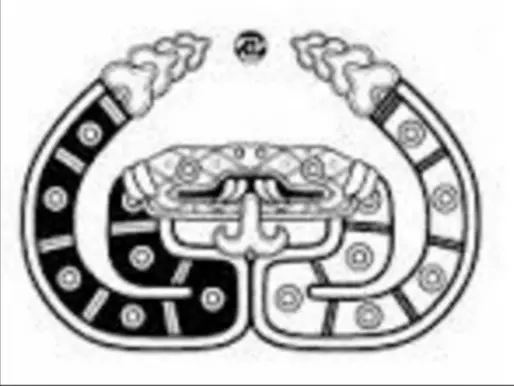
In mexica tradition, the first god to come into existence was ometeotl, the 'Lord Two', creator of all things and ruler of the thirteenth heaven: he contained the seeds of any duality and polarity that existed in potential in the cosmos. In turn, he split up in illo tempore in a feminine part (Omecíhuatl) and in a masculine part (Ometecuhtli). In the Mesoamerican perception we therefore find a primordial and unique god, who was considered otiosus because he lived at the peak of creation, in the 13th heaven, from which two portions of the very essence of the god emerge and begin again a long chain of creation of new divine entities, subject to them.
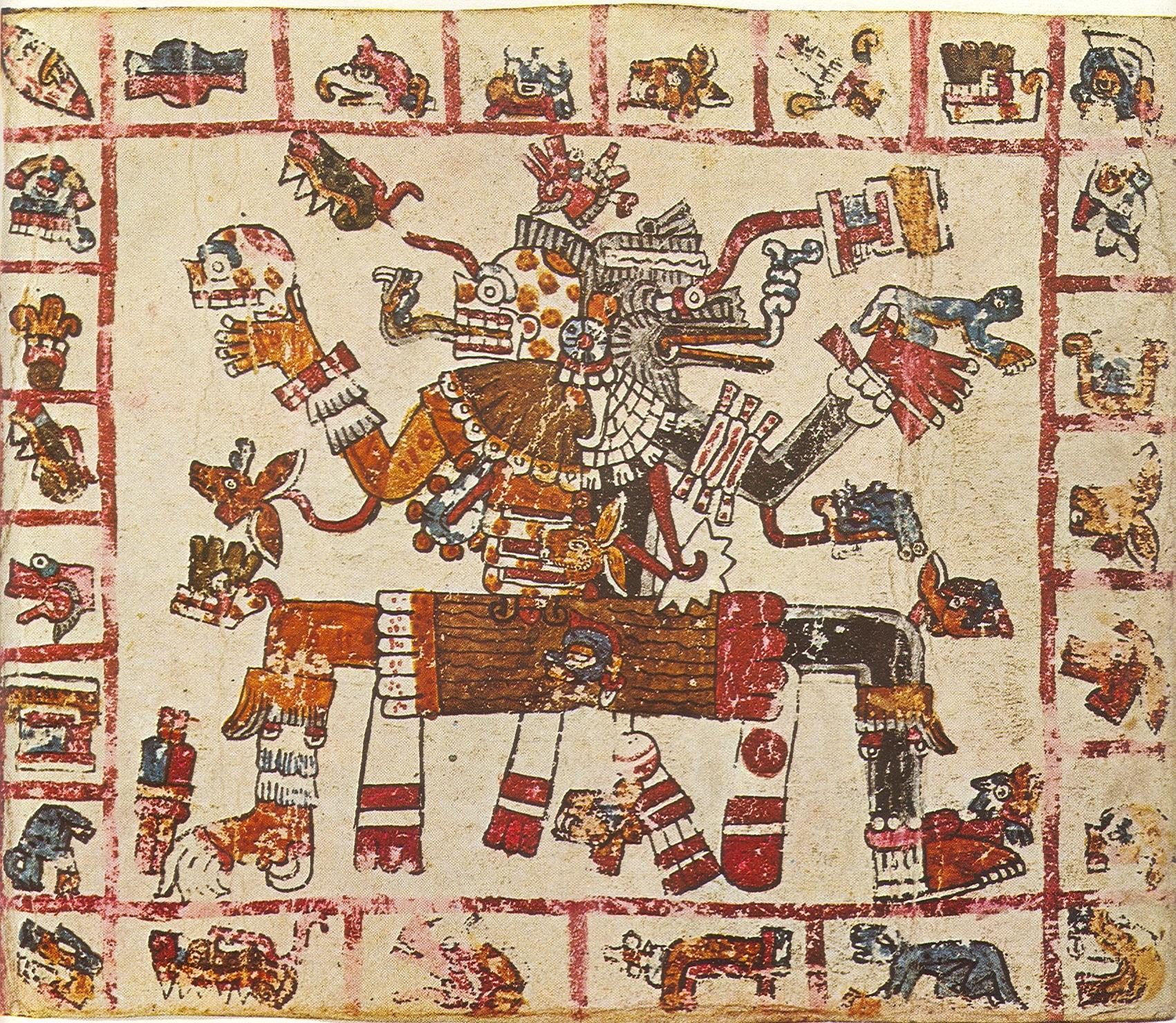
Germanic tradition

About the Ario-Germanic tradition, Guido von List noted that the primordial and invisible god is named surtur ("Stable in the primordial" or "stable in the eternal") "the Dark", At the same time the primordial substance and the 'Great Spirit' that hovers over the darkness of the primordial abyss, the 'spirit of salvation', a double mystery which later develops as a 'double unity', dividing itself into a masculine polarity (All satur, Universal Father, the first Logos, that is to say the god manifested as the 'Spirit of the World', creator of all things, demiurge) and in a feminine (Hyle, primordial matter / element, cosmic matrix of every being, Great Mother Goddess). The esoteric teachings of Armanism reconstructed by List therefore contemplated «a tripartition, or rather a triple state of the concept of God, whereby the original god was represented as androgynous, Namely bisexual»(The religion of the Ariogermans, p.36). In a first phase of creation, List continues, this occult god manifests itself precisely with movement, starting from itself, revealing himself as the first Logos, subsequently emanating from himself the first four elements. List calls Surtur "immeasurable latent force [...] uncaused original cause [...] impersonal original cause [...] 'the hidden god'[…] An impersonal, immaterial spirit, which it's time and space at the same time ".
Celtic tradition
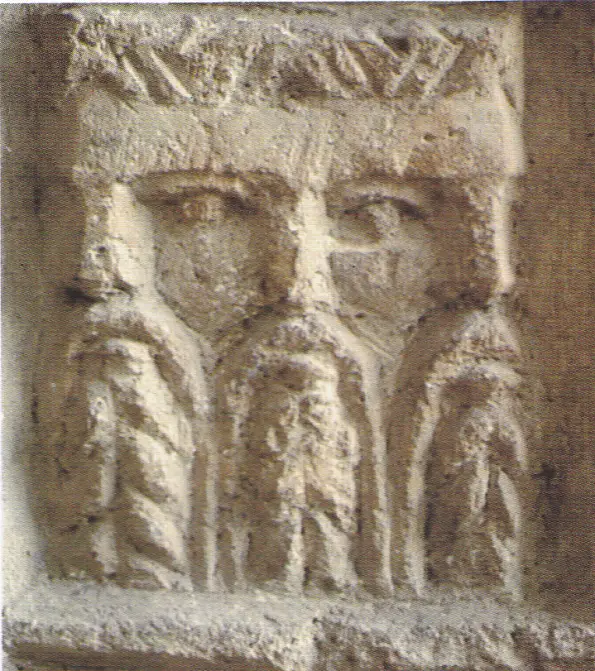
The Celtic peoples of continental Europe worshiped Lugos or Lug ("light" - but also the assonance with "Logos") as the supreme god, which Julius Caesar in De bello Gallico makes it correspond (rather superficially) to the Roman Mercury. He is often represented with three faces, like the Hindu Brahma, which signify the union of opposites present in his absolute divinity. It is the Celtic equivalent of Odin who, as we learn from Jean Markele, maintains the dual characteristic of the primordial Ario-Germanic god Surtur, almost for a handover (Druidism, p.82):
«Being at the same time Tuatha and Fomori, Lug participates in a double original nature, which will give it its exceptional character and, ultimately, beyond any classification. Indeed, not only does he have, of the Tuatha De Danann, the organizing power, socialized and spiritualized to the extreme, but he adds, of the Fomori, the brute, instinctive, unorganized but terribly effective force. Lug is a true synthesis of two opposing and fighting forces. It is the very embodiment of a philosophical monism, the personalized observation of the Celtic rejection of the principle of duality. "
Markele also informs us that the city of Lyon takes its name from the god (assonance with the lion, to keep in mind when we find equivalent gods endowed with the lion symbolism). The sacred animal in Lug however is the crow; the author explains with these words the reason for this apparent paradox (page 86):
«The name Lug is undoubtedly in relation to a root which means 'light' and 'whiteness' (Greek leukos, Latin luxury) and the raven, due to its black color, seems to express more night or darkness. "

Indian tradition
As is well known, the Trimurti Indian embodies the three main divine aspects, manifested in the forms of three important archetypal deities: Brahma the creator, Shiva the Destroyer e Vishnu the Preserver, often conceived as a single deity (hence the representation of a single god with three heads or faces; Sanskrit: trishiras, "Triple head"). According to the Hindu tradition, this triad of divine figures equates to three different aspects of the same and unique primordial god (sometimes called Īśvara by the śivaites). In some mythical narratives it is said that these first three gods were born from theprimordial egg deposed by Ammavaru at the beginning of time.
The three primeval Hindu gods are also associated with the To use, namely the three constitutive qualities of all that exists in the cosmos: Brahma is associated with the guna Slits, Vishnu to the guna sattva and Shiva to the gun Tlove. The primordial elements are also associated with them: Brahma represents Air, creator of life, which fertilizes the Earth (the goddess, variously called); Vishnu the water, which maintains life; Shiva the fire that continually destroys and transforms. However, the correspondences with the three functions and the elements vary according to the various local traditions: sometimes the creative function belongs to Shiva and the destructive one to Brahma. Among other peoples Vishnu rises to the state of supreme divinity relegating the other two aspects to his functions. In Kashmir and some areas of southern India, however, the śivaites worship Shiva as the embodiment of the triple principle of the entire Trimurti: this is artistically rendered by showing the body of Shiva and Vishnu and Brahma coming out of his left and right flank respectively.

In addition, the śivaita tradition also recognizes the original division of the god into two manifestations, one invisible and creative (Shiva, the god) and one visible and receptive (Shakti, the goddess). In this regard, we point out that even the very ancient Vedic god Varuna contains within it the two masculine and feminine aspects of divine intelligence, as can be understood from the analysis of the etymology of its original name Ua-ra-ana, 'son and daughter of (mother goddess) Ana', that is to say masculine polarity and feminine polarity originating from the primordial cosmic substance, at the same time spirit and matter (Mario Zisa, History of the mother goddess and the primeval triad).
Roman tradition: Janus
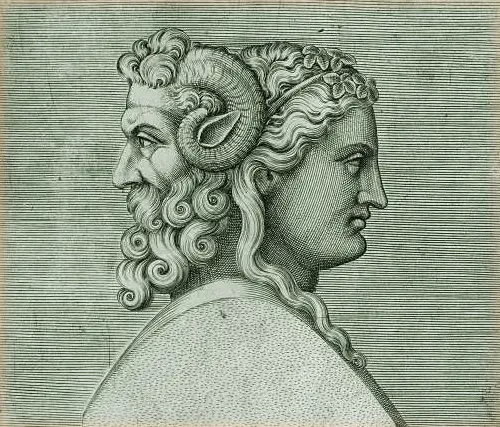
For the ancient Romans the primordial god is Janus (Ianus) two-faced, whose epithets are "god of the beginnings", "god of the gods", "father of the gods", "father of the morning" (the animal sacred to the god is the rooster, a solar animal that with its song inaugurates the day). Septimius Serenus calls him "principle of the gods and keen sower of things". Varro reports for Giano the epithet of Cerus (ie "creator"), because "how initiator of the world Giano is the creator par excellence ». The consul and augurs Marco Valerio Messalla Rufus writes in the book on Auspices that Janus is the one "who shapes and governs everything" and who "united by surrounding them with the sky the essence of water and earth, heavy and tending to descend , and that of fire and air, light and tending to escape upwards ", adding that" it was the immense strength of the sky that kept the two contrasting forces bound together ". It is interesting to note that the ancients put the name of the god in relation to the movement: Macrobius and Cicero derived it from the verb ire ("To go"), because according to Macrobius "the world always goes, moving in a circle and starting from itself to itself returns».
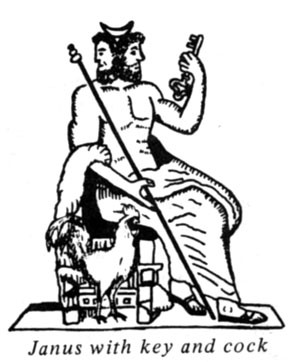 As for the strictly iconographic aspect of the god, he holds the rod (or scepter) in his right hand and the keys in his left. Guido de Giorgio notes that the duplicity of Janus's aspects, whatever form it takes, does not decompose the substantial unity of his divinity; this, according to the author, is a reference to the Primordial Tradition represented «by the unity of the two aspects or if you want from a third face of Janus which is not visible, nor can it be, in which the two visible ones are neutralized»(The Roman Tradition, p.182, italics ours). This third face of the god is equivalent to the "hidden god" of many archaic traditions, creator of everything and generator first of all of the primordial principles of masculine and feminine, active and passive, spiritual and material, spatial and temporal. But, while the dualistic manifestations that proceed from the Principle are visible in the representation of the two visible faces of the god, the third necessarily remains invisible, since virtually containing every potentiality of being, everything and the opposite of everything, it cannot be represented. Let us quote de Giorgio himself (p.182):
As for the strictly iconographic aspect of the god, he holds the rod (or scepter) in his right hand and the keys in his left. Guido de Giorgio notes that the duplicity of Janus's aspects, whatever form it takes, does not decompose the substantial unity of his divinity; this, according to the author, is a reference to the Primordial Tradition represented «by the unity of the two aspects or if you want from a third face of Janus which is not visible, nor can it be, in which the two visible ones are neutralized»(The Roman Tradition, p.182, italics ours). This third face of the god is equivalent to the "hidden god" of many archaic traditions, creator of everything and generator first of all of the primordial principles of masculine and feminine, active and passive, spiritual and material, spatial and temporal. But, while the dualistic manifestations that proceed from the Principle are visible in the representation of the two visible faces of the god, the third necessarily remains invisible, since virtually containing every potentiality of being, everything and the opposite of everything, it cannot be represented. Let us quote de Giorgio himself (p.182):
«The bi-faciality of Janus represents the equivalence and equivalence of the opposites in the substantial and invisible unity of the god. Thus, if we speak of the past and the future, the neutral term of resolution will be the present which does not exist in time, but only in eternity: in other words, bifaciality supposes the facticity that includes it and which is the Supreme among the two extremes. "
This bifaciality (o trifacial, like the Hindu trimurti) which characterizes only Janus among all the gods of the ancient Latins, undoubtedly makes him the primordial and original god of Roman theogony. De Giorgio himself also agrees on this (p.184):
"Janus is the god par excellence because he represents the vehicle that guides the other gods: now, if these are symbols of determined cosmic forces, he, in his indeterminacy that allows all determination, must conceive himself as the divine principle and the deepest foundation of Roman tradition. "
Furthermore, the Author points out that "the relationship between Saturn and Janus was so close that the first was consecrated the month of December and the second that of January" (The Roman Tradition, p.181); this should be borne in mind when we will shortly analyze the marriage between Aion and Cronus in the theogony of the ancient Greeks. But now let's see what the Orphic Mysteries handed down regarding the god of origins.

Orphic Mysteries: Phanes

In the Orphic cosmogony the primordial god is named Phanes (from the ancient Greek Φανης Phanes, "Light") and has the epithets of Protogonos ("The first born") e Erikepaios ("Giver of life"): it is a question, therefore, of a primeval divinity of procreation and of the origin of life. According to the myth, Phanes emerged at the dawn of the universe from the cosmic egg laid by Chronos (Time) and Ananke (Necessity) as the first and only principle. He was hermaphrodite, he was the first King of the Cosmos and from him everything was generated. Subsequently, disinterested in domination (as it was everything and, therefore, he could not command anything that was not himself) he gave the scepter to his daughter Nyx, the Night, who in turn gave it to Uranus. Both the iconographic representation of the god and the myths concerning him denote him as the stink divine par excellence: the first spark of the Logos that gave way to creation. It should be borne in mind that one of the hermetic fragments of the philosopher Heraclitus (fr. 52), concerning the god Aion (which we will analyze immediately below) reads:
"Aion is a child who plays by moving the pieces on the board:
sovereign power belongs to a child. "
The symbol of the stink divine born of the cosmic egg, albeit with the necessary adaptations to the zeitgeist who from time to time presents himself, has survived over the millennia, appearing in the myth of Horus as in that of Jesus, "the first born", "the only begotten son of God", "born without conception": he is the first and the last, the alpha and the omega, exactly like Janus and Aion. In the fifth century the belief of Christ spreads pantokrator, organizing principle of the cosmos, generated and not created by God the Father, the key to understanding reality and the answer to the mystery of existence. Jesus, like many other gods previously, rises to the symbol of the incarnate Logos, reason and structure of the cosmos. Not only that: speaking of the symbol of stink divine, it still survives even today in profane culture. An example of this can be found in the final scene of Stanley's film Kubrick 2001: A Space Odyssey, in which the astronaut protagonist, now at the height of his cosmic epic, as an old man (Kronos, omega) is reborn again in infinite space under the guise of a child of light contained in the cosmic egg (Aion, alpha). But let's not digress and let's analyze the aforementioned Aion.
Hellenic tradition: Aion
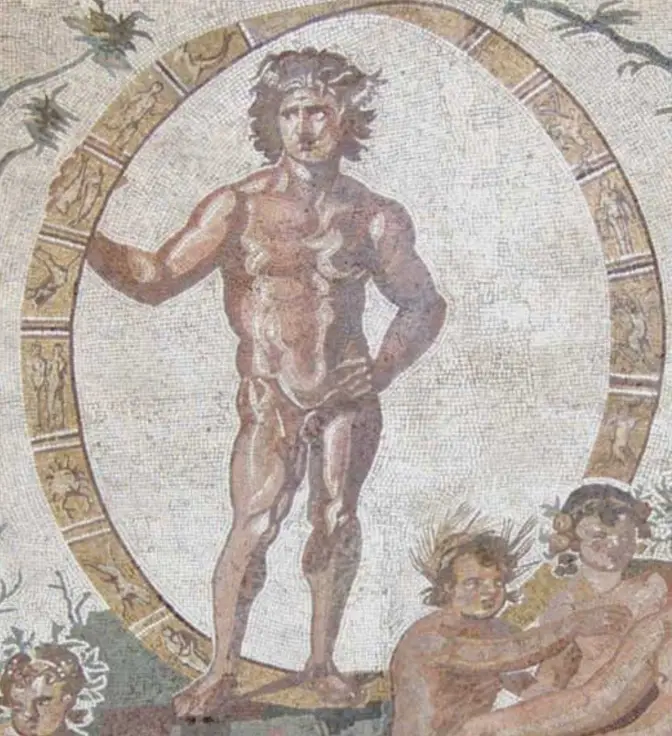
If Phanes was a primordial god of the Orphic mysteries, in the rest of the Hellenic peninsula of late antiquity the primordial and all-encompassing god was called Aion (in ancient Greek αἰών, "aeon"). According to the scholar of myths, symbols and alchemy Marie-Louise von Franz, a student of Jung, Aion is the "guardian of the gates" in the Mithraic mysteries; in support of this she points out that he is depicted holding a scepter and a key (attributes, moreover, also of Janus). Aion was considered the god of infinite time, creator and destroyer of all things. Uranos and Kronos were the two primary manifestations of him: to Uranus (the sky, space) a creative function was recognized, to Cronos (time) a destructive function.
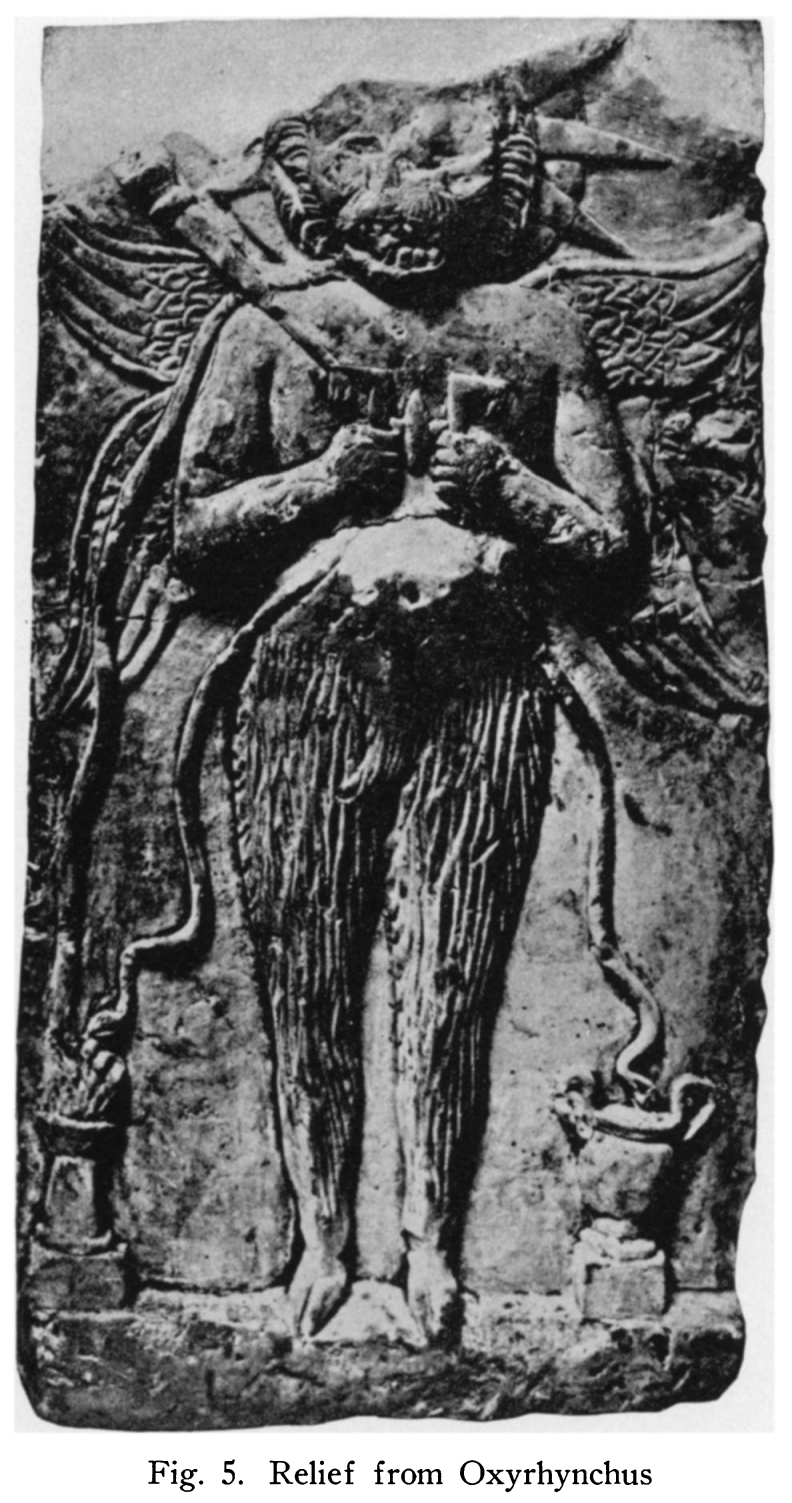
The Orphic hymn dedicated to Cronus defines him as "father of the blessed gods and men", "universal parent of time", "origin, development and decline" (creative function, conservative function, destructive function). The person praying addresses him with these words: "you who consume all things and again you yourself increase them", "you who possess the indestructible bonds of the infinite world", "you who live in all parts of the world" . Indeed, it would seem that we are reading a hymn to Shiva, who "in the fullness of time, always dancing, destroys all forms and names with fire, starting a new pause" (AK Coomaraswamy, The Dance of Shiva). Returning to the Greek context, we can deduce from the Orphic hymn how Cronus and Aion are the same god, with the only difference that Aion appears to be the primordial manifestation of Kronos, preceding the original partition between space and time, spirit and matter, light and darkness. If, in fact, Aion is infinite time (originally not separated from space), Kronos is instead the finite, cyclical and inexorable time, the bearer of death and destruction (the symbolism of the sickle). The correspondences with the trimurti Hindu (Brahma-Aion, Vishnu-Uranus, Shiva-Cronus) are more than evident and need no further explanation [cf. Cyclical time and linear time: Kronos / Shiva, the "Time that devours everything" e Apollo / Kronos in exile: Ogygia, the Dragon, the "fall"].
Marie-Louise von Franz also reports an invocation to Aion (The experience of time, p.12) contained in Papyri Graecae Magicae, which reads as follows:
"I greet you, you who fill the entire structure of the air, a spirit that extends from heaven to earth ... and to the edge of the abyss ... spirit that also penetrates me and makes me rise again [...] immense, circular, mysterious form of the universe, celestial spirit, ethereal, terrestrial, fiery, windy spirit, spirit of darkness ... of light, shining like a star ... Lord, god of Aion, master of all. "
In this invocation, Marie-Louise von Franz recognizes «an image of the dynamic aspect of existence», of what today we could call a «principle of psychophysical energy». All opposites (change and duration, time and space, light and darkness, life and death, spirit and matter) are contained in this primordial cosmic principle (p.12). According to Franz, this duplicity is also found in the iconographic representation of the god (p.23):
“Its lion's head indicates summer and its fiery nature; the snake its wintry and wet aspect. Often the body of him or the snake is engraved with the signs of the zodiac. The faithful invoke him as the soul of the world, as an all-encompassing spirit, light and dark, ruler of all things. For the initiate he is the Lord of Light who opens the gates of the afterlife. "
Furthermore, according to the author, the Greeks by "aion" did not only mean the primordial god, but also the immortal soul that animates the recesses of every conscious individuality, the vital breath that survives physical death, the pneumatic. In fact, according to the author, aion (p.10):
«[…] Originally meant the vital fluid present in living beings and, consequently, the duration of their life and the destiny assigned to them. This fluid continued to live even after death, taking the shape of a snake. It was a 'generating substance', as was all the water present on earth and in particular Ocean-Cronus, the creator and destroyer of everything. The philosopher Ferecides taught that the basic substance of the universe was time (Cronus), from which fire, air and water derived. "
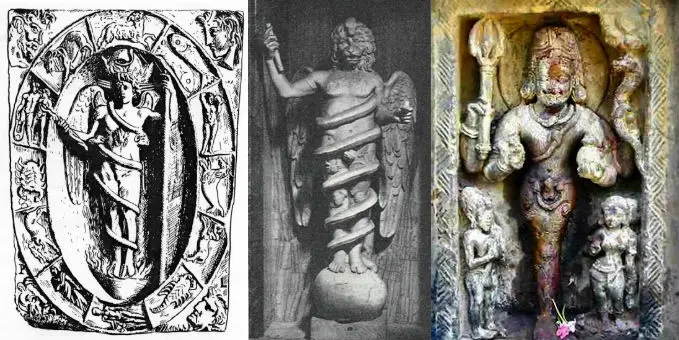
Persian tradition: Zurvan
It is inevitable to note the incredible iconographic similarity existing between Aion and numerous other gods of the most disparate ancient cultures. Entirely identical to Aion is first of all the Persian Zurvan (or Zervan) god of time and destiny, who in the Iranian theogony is even placed in a higher position than that of Ahura Mazdā and Ahrimane, the two primordial principles, respectively of good and evil. Zurvan would therefore be to Aion (and to Brahma) as Ahura Mazdā is to Uranus (and to Vishnu) and Ahrimane to Cronus (and to Shiva). Franz also confirms that in the Hellenistic era Aion-Cronus was identified with Zurvan, further adding that the ancient Persians distinguished two aspects of this supreme deity: Zurvan akarana (the «Infinite Time», therefore equivalent to the Aion proper) and Zurvan dareghochvadhata ("The Time of the Long Dominion", equivalent to Cronus). The latter was the cause of decay and death and was sometimes identified with Ahrimane, the principle of evil (p.12).

Gnostic tradition: Abraxas
In the Gnostic-Mithraic mysteries the supreme god is Abraxas, which in the Persian tradition comes to symbolize the union / totality between Ahura Mazdā and Ahrimane: Abraxas is therefore equivalent to Zurvan akarana, in Aion, in Janus (it is no coincidence that he is depicted with the head of a rooster, the animal of the beginnings, also sacred to the primordial Latin god). In place of legs Abraxas has two snakes: in this way the coexistence of the masculine / solar / luminous / creative / summer / dry (lion or rooster) and the feminine / lunar / dark / destructive / winter / wet (snake) principle is fully respected. Carl Gustav Jung also studied the Abraxas archetype, concluding that the god represents the first cause of all manifestations and at the same time the same formless matter, preceding all order and form. Abraxas, according to Jung, is the root of all and of all duality, since every manifestation of being is nothing but a split or perceived aspect of its dynamism. With this poetic hyperbole Jung speaks of Abraxas:
“Abraxas utters the hallowed and cursed word which is life and death at the same time. Abraxas generates truth and lies, good and evil, light and darkness, in the same word and in the same act. Therefore Abraxas is terrible. He is as splendid as the lion the moment he kills his prey. It's as beautiful as a spring day. Yes, he is the big Pan himself and the little one too. He is Priapus. He is the monster of the underworld, a thousand-armed octopus, tangled knot of winged snakes, frenzy. It is the hermaphrodite of the very first beginning. He is the lord of the toads and frogs that live in the water and trample the earth, who sing in chorus at noon and midnight. It is fullness that unites with emptiness. It is the holy coupling, it is the love and the murder of him, it is the saint and the traitor of him. It is the brightest light of the day and the darkest night of madness. Seeing it means blindness. Knowing him is disease. Worshiping him is death. Fearing him is wisdom. "
Traces of the cult of Abraxas can be found not only in the psychology of the depths but also in the literature of the twentieth century: in his initiatory novel Demian, the German writer Hermann Hesse (a close friend of Jung, deeply influenced by his visions) summarizes in a few words the entire symbolic complex of the god:
“The bird struggles to get out of its shell. The egg represents the world. Whoever wants to be reborn must destroy the old previous world. The bird flies high in the direction of divinity… God is called ABRAXAS. "
Other symbolic iconographic correspondences
Continuing with the iconographic correspondences we arrive in Africa, in Lower Egypt, where the ancient Nubians worshiped apedemak, a god represented with a triple lion face and four arms, which they considered Isis's husband.
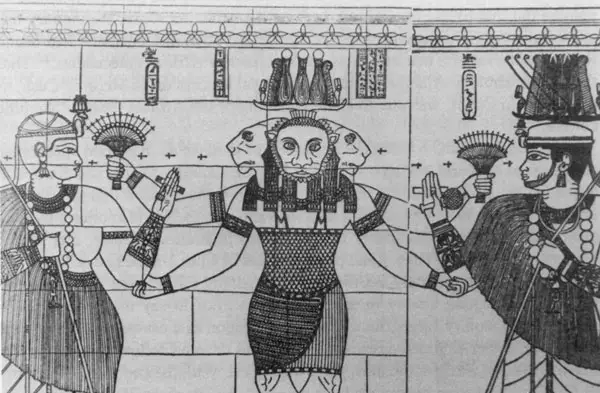
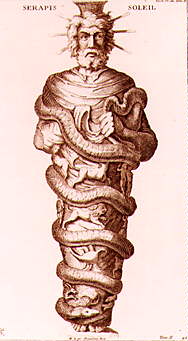
We find another impressive iconographic correspondence, again, in India: we are referring to that very mysterious god named Ekapada, a supreme manifestation of Shiva who is depicted as an anthropomorphic being, sometimes with a lion face, holding a torch (in the same way as Aion and Phanes) or, alternatively, with three legs or with two figures, representing Brahma and Vishnu, which emerge from his body. In Alexandria, Egypt, in the Ptolemaic period, the iconography of Aion was revived in the cult of Serapis. However, at this point in history, the sacred symbolism of the primordial god had probably already been forgotten and the proof is found in the multiple interpretations of the god, initially equivalent to the Semitic Ea, then equated from time to time with Zeus, Hades, Helios, Dionysus and Asclepius.
Conclusion
We have thus analyzed the esoteric symbolism and iconographic correspondences in some of the most ancient religious traditions. Other cultures could have been cited, such as Sumerian and Egyptian, or the mythical narratives about the primordial god by the indigenous peoples of Melanesia or other peoples. However, for the moment we stop here, pointing out how, in all the traditions we have analyzed, we find the same triple pattern everywhere:
- At the beginning there is a primordial god, double but undifferentiated, at the same time spirit and matter, everything and the opposite of everything;
- Then comes the emanation from the Primordial God of a creative / masculine / luminous / spiritual e polarity
- of a destructive / feminine / dark / material.
Sometimes the trinity is presented as a single god with three faces (Brahma). Other times the masculine and feminine aspects of the god (Shiva-Shakti) are represented and the original undifferentiated aspect cannot be represented in any way except by symbols (Phanes, Aion, Abraxas). Still others the primordial god is represented hermaphrodite, at the same time male and female (the Androgyne, in this regard see Mircea Eliade, Mephistopheles and the Androgyne). In more than one myth, the god of origins is born from a cosmic egg; in this sense, there is a red thread that starts from the Orphic myth of Phanes to reach that, always Hellenic, of the Phoenix reborn from its own ashes.
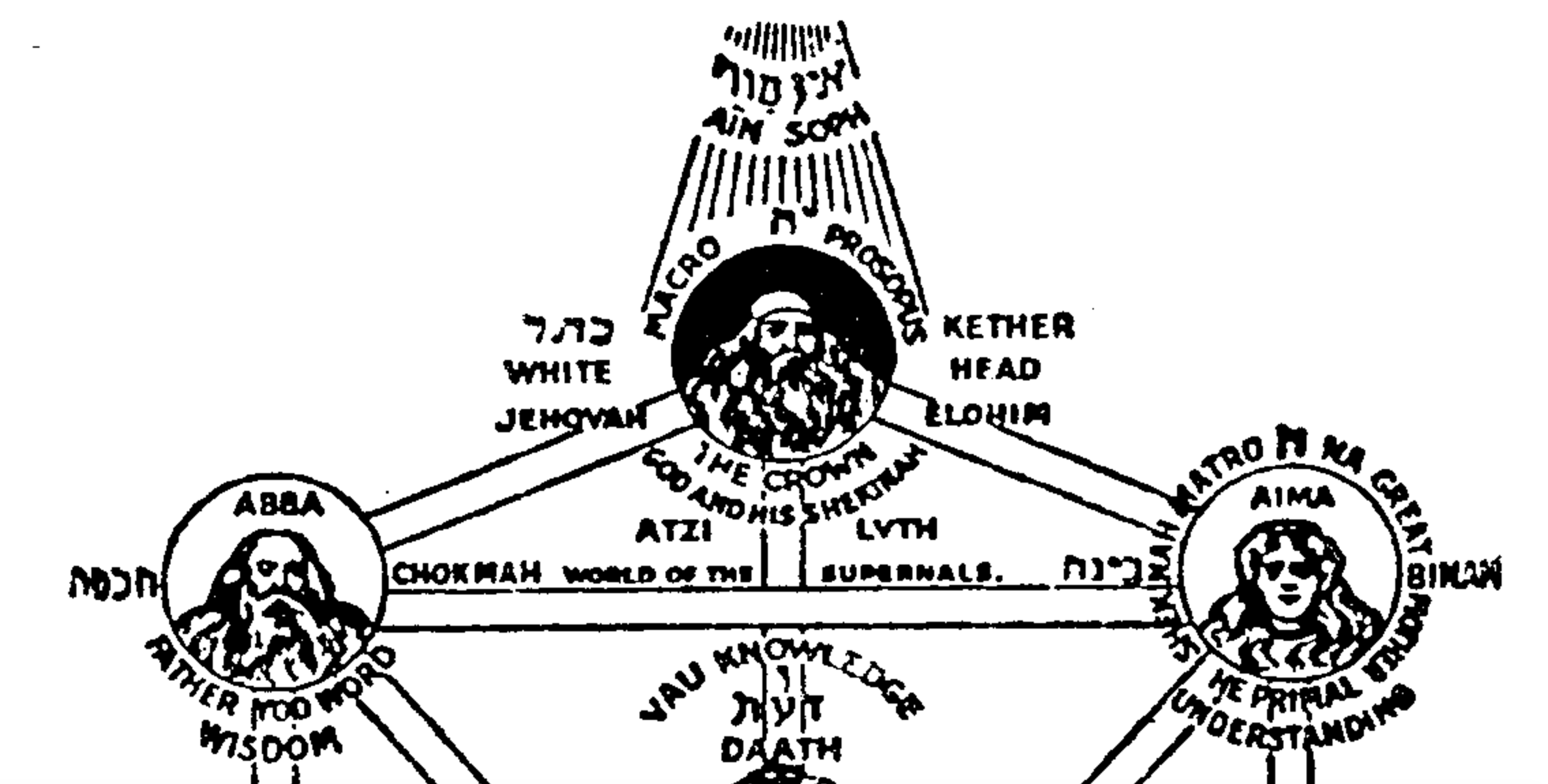
In all traditions, after the primordial partition the original god withdraws, gives up his dominion to the masculine principle and becomes a deus otiosus. Thus, for example, Varuna cedes sovereignty to Indra, Aion to Kronos, Janus to Saturn, Surtur to Allsatur and so on. The bipartition into two polarities of the primordial god - and the consequent tripartition of being in all its planes, the universal mystery on which the Christian dogma of the Holy Trinity is also based - is, on the other hand, the foundation on which they are based the esoteric teachings of an immensity of ancient traditions, not only of Indo-European origin as claimed by George Dumézil. As a further example of this we mention the supreme triad of the tree sephirotic of the Hebrew Kabbalah, formed by Kether (undifferentiated principle, Supreme God), Chockmah (male principle, God the Father) e Binah (female principle, Mother Goddess). Individual traditions, the names of the gods and denominations change, but the most sacred truths of the primordial Tradition are still alive behind the veil of maya, waiting to be found by the most tireless travelers.
Bibliography:
- Guido de Giorgio, The Roman Tradition (Mediterranean, 1973).
- Marie-Louise von Franz, The experience of time (Tea Two, 1997).
- Guido von List, The religion of the Ariogermans and Urgrund (Seventh Seal, 2008).
- Jean Markele, Druidism - Celtic religion and divinity (Mediterranean, 1991).
- Mark SG Dyczkowski, The doctrine of vibration in Kashmir tantric śivaism (Adelphi, 2013).
- Yolotl Gonzalez Torres, The cult of the stars among the Aztecs (Mimesis, 2004).
- Mircea Eliade, Mephistopheles and the Androgyne (Mediterranean, 1971).
- Gabriella Ricciardelli (edited by), Orphic hymns (Mondadori, 2000).

He posted it back up the age of innocence.